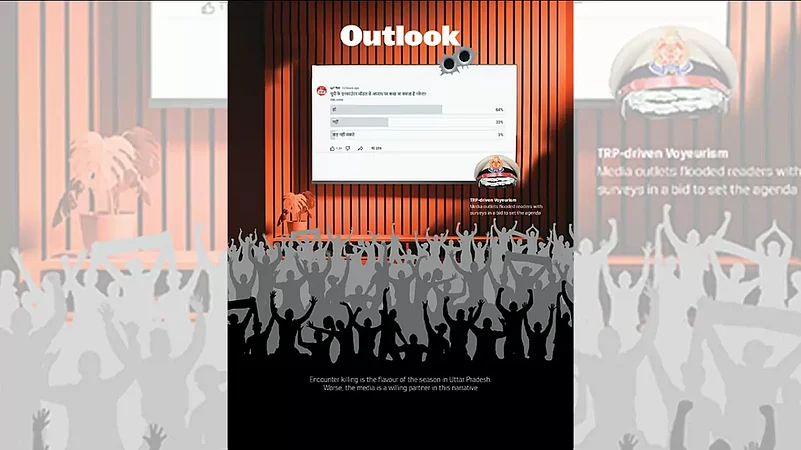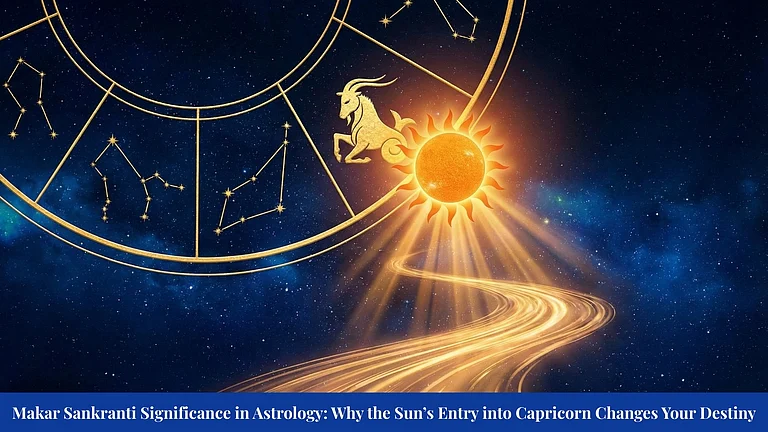1. “Yogi model apraadh or apraadhiyon ko rokne ka sabse bada ilaaj hai” (Yogi model is the biggest remedy to crime and criminals)
2. “Surrender karna hi aakhri rasta hai kyunki surrender na karne ka natiza aaj sabke samne hai” (Surrendering is the only option. The result of not surrounding is there for all to see)
3. “Aur kaun chahta hai Atiq Ahmed ka encounter?” (Who else wants Atiq Ahmed’s encounter?)
4. “Ab Don ki begum ka number” (Now it’s time to get the don’s wife)
5. “Yogi ji ne kaha tha mafia ko mitti mein mila denge, mila dia” (Yogi ji had said we will destroy the mafia, he did it)
These were some headlines made on prime-time news shows after the deaths of jailed gangster and former Samajwadi Party (SP) leader Atiq Ahmed and his son Asad. While Asad, 19, was gunned down by the Uttar Pradesh Special Task Force (STF) in Jhansi on April 13, two days later, Atiq and his brother Ashraf were shot dead at point-blank range in Prayagraj. Both were accused in the February 23 murder of Umesh Pal—a key witness in the 2005 murder of Bahujan Samaj Party (BSP) MLA Raju Pal.
Ahmed and his brother were shot dead by three persons who posed as journalists and the murders happened in the presence of police and media. The visuals of their shootout were shown “live” and played in loop. A few hours later, some TV channels blurred the disturbing videos, however, by then, unedited versions were all over the social media.
“There are certain rules and international reporting guidelines that every news organisation needs to follow when reporting on violence and other sensitive issues,” says Geetartha Pathak, Indian Journalists Union president. He adds: “Showing dead bodies, blood and gore can exacerbate tensions and hate, especially when the news involves people from two communities.”
The rating-driven media has lapped up the recent encounter-murder stories. However, a year ahead of the General Assembly elections, the media frenzy over the killing of powerful Muslim gangsters and former politicians in UP—an important state for the ruling Bharatiya Janata Party (BJP)—seems to be going beyond the usual TRP-driven voyeurism and setting the narrative template for media coverage in the upcoming poll season.

The daylight murder and extrajudicial killings of gangsters have been hailed as a success for chief minister Yogi Adityanath. After Atiq’s death, a media organisation commissioned a survey in UP. Responding to a question, a majority said the deaths of Atiq, Ashraf and Asad would benefit the BJP.
The media has not shied away from this narrative as could be seen in the suggestive headlines and character assassination of Ahmed’s absconding wife “don ki begum” Shaista Parveen, one of the accused in the Umesh Pal murder case.
Who Sets the Narrative?
On April 14, a day before Ahmed was killed, former Jammu and Kashmir Governor Satya Pal Malik gave an interview to senior journalist Karan Thapar in which he claimed that Prime Minister Narendra Modi had asked him to stay silent over alleged lapses flagged by him in the aftermath of the 2019 Pulwama attack in which 40 Central Reserve Police Force (CRPF) personnel were killed.
What had the potential of becoming an explosive blow to the ruling party remained largely missing from the news cycle. While it was relegated to inside pages, the fact that it was not slotted for most prime time debates is perhaps telling. However, on April 16, the murder of two Ahmed brothers made it to most front pages. The visuals were played out on TV the next day as well and related hashtags were trending on Twitter.
‘Encounters’ Make a Great Story
On September 20, 2018, local journalists in UP’s Aligarh district got a call a 6:30 am from the police asking if they wanted to “watch and film a real police encounter”. The police said they had been looking for Mustakim and Naushad—“wanted in six murder cases”. The duo allegedly fired 34 rounds before they were taken down. The journalists—who were not wearing protective gear—were asked to stay “100 metres away”. When asked why journalists were called, Aligarh SSP Ajay Kumar Sahini said: “There is nothing wrong in it. We wanted to provide first-hand information to the media.”
Kanpur-based journalist Avanish Dixit, who has been covering crime and encounters in UP for over two decades, recalls a 2005 incident. The Kanpur Police had arrested Rafiq, a key member of Kanpur’s dreaded D2 gang, from West Bengal, and had brought him back. The court had granted the cops a one-day remand as Rafiq had allegedly confiscated a firearm that had been used to kill Dharmendra Singh, an STF officer, recalls Dixit.
While Rafiq was leaving the court, he told Dixit he feared he would be killed. “That night, he was killed by three assailants in police custody. Even then, the media had frenziedly demanded Rafiq’s encounter. They also portrayed the killing of the STF officer as a moral justification for the police encounter or killing of gangsters,” says Dixit.
Controlling Media Machinery
On May 22, 1987, over 40 Muslim men from a small neighbourhood in Hashimpura, Meerut, were rounded off by the Uttar Pradesh Provincial Armed Constabulary (PAC) and killed in broad daylight.
The incident remained unreported. After a week, only a small regional newspaper called ‘Chauthi Duniya’ carried the report. According to an Outlook report published in 2015 titled ‘The Cold Blood’, the editor of a leading newspaper had reportedly refused to run a story on the incident even after being informed by sources.
It was only in 2015, however, that the case finally became known when all the officers accused in the case were discharged due to lack of evidence. Many at that time questioned the Congress government, which was in power at both the centre and the state.
“There is nothing new in the state’s attempt to control the media to serve its political narratives. What’s new is the way the media industry has changed and become completely corporatised,” says Pathak. “The media’s role should be one of asking for accountability from the government. Instead, it ends up celebrating the government’s every move. It manufactures consent and applause, even for misdemeanours,” he adds.
Researcher Saroj Kumar Aryal, who teaches at the Faculty of Political Science and International Studies in the University of Warsaw, Poland, also feels that in the modern era of capitalism, ‘free press’ cannot truly exist. “But in the current media environment in India, it seems like a syndicate run by an individual who handpicked the issues based on the instruction given by some supreme body,” says Aryal.
Perfecting The Narrative
In India, crime reportage usually relies on the “institution driven model”. Under this, the police or law enforcement becomes the prime source for news and information around developing events. As opposed to this model is the ‘event driven’ reporting of news, which forces media organisations to rely on sources other than official since the suddenness of the event does not allow for planned narrative setting.
Aryal, who has co-authored the paper “Changing The Media Landscape In India Under The Modi Government”, explains that most media narratives today follow the “Narrative Policy Framework” (NPF) that shapes and informs content, flow and tonality. He explains that there are four key components of a “narrative”— setting, characters, plot, and moral.
Setting refers to a situation that is related to a certain policy problem or context. In UP, the larger context of Adityanath’s war on the “goonda raj” and the “Hindu khatrey mein hain” (Hindu is in danger) narrative provides a ripe setting.
Second, it requires at least one character—a victim, a villain or a hero. In the Atiq Ahmed case, the victims were Umesh Pal, and his elderly mother who repeatedly appeared on news channels and sought blood for blood. Alleged videos of “villains” Asad and Ghulam gunning down Umesh were broadcast on loop. In the end, UP police and the state government were shown as heroes.
Third, the plot establishes the arc of action in which events interfere with the actions and environments, often structured in the beginning, middle and end sequences, Aryal outlines. And fourth, morality gives the reason for the acts and intentions of the characters.
A Game of Showmanship
A UP-based journalist covering encounters for a national TV news channel says that in most cases, police themselves shoot the videos of encounters and share them with media as they want to become “viral” or are looking for a promotion.
Rajeev Yadav from Rihai Manch, a non-profit that works for undertrials and victims of police encounter, states that it’s not uncommon for media persons to be called for “covering” encounters in UP and that police often use such tactics to frame innocent people.
In 2018, a news channel ran a sting operation to “expose” how police officials in Agra accepted bribes to frame innocent people and then “encountered” them. Yadav mentions the case of fruit seller Ikram from Baghpat, who was shot dead by police in Kairana in 2017. Police framed him in a case of robbery but his family claims he was innocent.
“Nowadays, when we see media OB vans chasing a criminal, we know that an encounter might happen,” says Dixit. He reminds that when Vikas Dubey, a gangster-turned-politician from Kanpur, had been encountered, media had started following his convoy from Ujjain. It was only after the convoy entered Kanpur that the police were able to put up a barricade and stop the media. Dixit feels that while reporters and independent content aggregators on the ground often cover the news from a non-biased perspective, bigger media channels and outlets buy their footage and add their own agenda to it. “We treat all crimes and criminals the same, just like we treat all police officers neutrally,” says Dixit.
Aslah Kayyalakkath, journalist and founding editor of independent media outlet, Maktoob Media, agrees that media “should prioritise honesty over secularism while reporting on Muslim subjects”, including gangsters and criminals.
“It is disheartening to see that, in many instances, mainstream media portrays itself as an adversary to minorities, as is evident in the Atiq murder case,” Kayyalakkath says.
(Edited by Swati Subhedar)


























